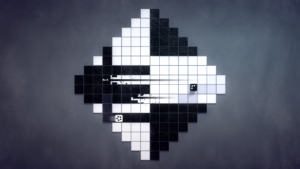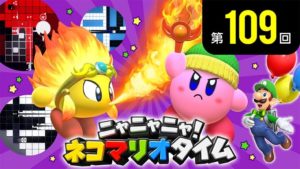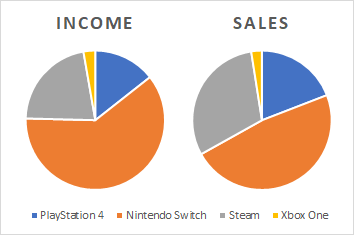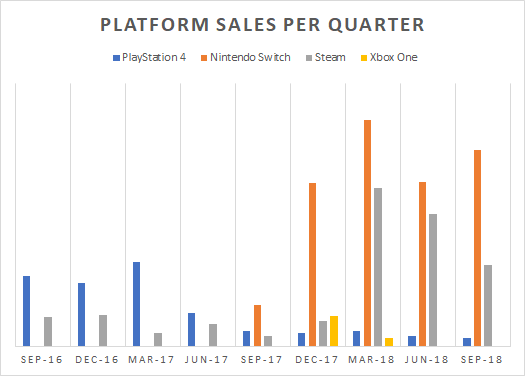 I’ve always made time for reading postmortems about sales. They were useful when I first considered going indie and are still useful today with over two years of selling INVERSUS behind me. Whenever peers ask how the game did (or is still doing), I find it hard to frame the answer. INVERSUS is not an obvious runaway success nor is it a failure. It sort of “does well enough” given how my solo studio, Hypersect, is run. Hopefully sharing some specifics of how it has sold will in turn help you evaluate past and future decisions.
I’ve always made time for reading postmortems about sales. They were useful when I first considered going indie and are still useful today with over two years of selling INVERSUS behind me. Whenever peers ask how the game did (or is still doing), I find it hard to frame the answer. INVERSUS is not an obvious runaway success nor is it a failure. It sort of “does well enough” given how my solo studio, Hypersect, is run. Hopefully sharing some specifics of how it has sold will in turn help you evaluate past and future decisions.
Let’s start with the big numbers
INVERSUS first shipped on August 16, 2016 and I’m going to be discussing its performance up to September 30, 2018 (the end of Q3 2018). I also can’t reveal exact details per region per storefront, but I will try to be as open as possible. In regards to money, I’ll only be discussing the income actually received by Hypersect after everyone else has taken their cut and before taxes.
Hypersect directly earned over $325,000 USD from over 50,000 sales of INVERSUS during its first two years.
And now for some context
If you want to map any of these numbers onto your past or future experiences, you will need a better understanding of how Hypersect functions and how the game was built.
- Hypersect is a single person studio. This is a huge factor when it comes to calculating how much I need to sell in order to be sustainable.
- Hypersect is run from my apartment. I do not not have a separate office.
- INVERSUS is built on entirely custom technology. No third party game engine receives cut of earnings.
- INVERSUS is self published on all platforms in every region except for PlayStation 4 in Japan which is published by CrossFunction. Thus, in almost all instances, no publisher receives a cut of earnings.
- INVERSUS is priced at $14.99 USD in the United States. Prices for other territories were chosen on a per platform basis according to recommendations and conversions of other $14.99 games. There is an exception for PlayStation 4 in Japan where it is sold for ¥1,296 (similar to a $12.99 game in the United States).
- Ignoring the cost of my living, INVERSUS was built with minimal expenses. I contracted out the music, displayed at conventions, paid for some development hardware and software, did a short PR push with Evolve, paid for localization, had publishing support on the Japanese eShop from Kakehashi Games, paid some lawyer bills, etc. While I didn’t spend the time to tally up expenses for this discussion, I can say that conventions would have been the largest cost and I’d guess it all totals to somewhere near $30,000 USD.
- In addition to making games, Hypersect also outsources help to other studios. I was rather conservative during INVERSUS’s development and did enough contract work to cover my living expenses. As a result, I am in a better position to invest more in my next project. I am also fortunate in having enough experience/reputation as an engineer that this did not require allocating too much of my time, but it did pull my focus in different directions.
Performance over time
Taking a look at quarterly sales over time, we can see some trends.
It is rather clear that INVERSUS sold far better in its second year than it did in its first. I attribute this to a few factors:
- After one year, INVERSUS rebranded as INVERSUS Deluxe which included all of the post-launch support from year one along with a large content expansion and improved visuals. This was a free update to all existing players and a far better version of the game.
- INVERSUS Deluxe launched on new platforms with Nintendo Switch being the most notable. Nintendo Switch had less competition and was more suited to the game’s design than any other platform.
- I had become far better at selling INVERSUS. After my first year of stumbling through the dark, I had more business experience and more connections. I also had a better understanding of the game’s strengths and weaknesses.
You can also see that discounts become more prevalent in the time following a release as the units per quarter starts to grow faster than the income per quarter. This ratio then resets when INVERSUS Deluxe shipped on new platforms and is now back to decaying.
Performance per platform
Nintendo Switch is the dominant platform. It is also the platform where INVERSUS has earned the most money per copy sold. This ratio is even higher in Japan (about 40% Nintendo Switch sales) where the game has only ever been discounted twice. An interesting counterpoint is the performance on PlayStation 4 in Japan where it has the lowest earnings per unit sold. In this case, the game has a lower base price, there is a publisher that receives a cut of each sale, and most sales came from a heavily discounted promotion of 70% off.
You’ll also notice that the game didn’t hit the mark on Xbox One. Xbox was not one of the initial launch platforms (PS4 and PC), but instead part of the INVERSUS Deluxe release one year later along with Nintendo Switch. It’s hard to prove what went wrong here, but I suspect part of it relates to the press coverage and general zeitgeist focus on Nintendo Switch burying the Xbox news. I’m still considering ways to inch the Xbox performance closer to expectations. More on that later.
Platforms over time
Splitting the quarterly charts up per platform paints a more detailed history.
At this granularity it is hard to see the direct effect of individual sales, but as expected, any time the game has been sold at a discount there is a bump in units moved. I’ve certainly gotten better at scheduling discounts as time has passed, but in this manner, INVERSUS is similar to most every other title you’ve read about.
I’d like to discuss factors more unique to INVERSUS. Specifically, you can see that Nintendo Switch had an extended period of growth compared to other platforms, and you can also see that Steam sales had a resurgence in Q2 2018. I can point to some key moments that caused these behaviors so let’s walk through a timeline.

- Aug 16, 2016: INVERSUS launches on Steam and PlayStation 4.
- Sep 28, 2017: INVERSUS Deluxe launches on Nintendo Switch and releases as free update for Steam and PlayStation 4 players.
- Oct 4, 2017: INVERSUS Deluxe launches on Xbox One.
- Jan 8, 2018: INVERSUS is part of the Nindies New Year Sale on Nintendo Switch.
- This was a sale coordinated by another developer with the idea being to create an event worthy of promotion by the platform through the collaboration of multiple quality titles. The sale was featured on the eShop and the results were very positive, but more importantly this process helped me learn the value of collaboration with other teams. I also better came to understand a specific strength that INVERSUS possessed: While the minimalist aesthetic of INVERSUS might steer it towards a niche market, it is still a well crafted game with a sharp design that other developers respect and are comfortable being presented alongside.
- While The Nindie New Year Sale was only a featured promotion in America and Europe, INVERSUS also went on sale in Japan. This was notable because it was the first time the game was discounted on the Japanese eShop, and it resulted in performance similar to launch week.
- Jan 25, 2018: The free INVERSUS Deluxe Demo launched on Nintendo Switch.
- In my experience, most advice about demos says that they are not worth the risk. I followed this advice for a long while, but eventually convinced myself it was not the case for INVERSUS. The visual design is important to the game design, but results in screenshots that do not sell copies. INVERSUS is about complex strategies emerging from a very simple set of rules and I believed that actually playing the game would be better for converting sales. The marketplace on Nintendo Switch eventually pushed me over the edge here because while there were already far less games competing than on other platforms, there were also far far less demos available and that created an opening for free advertising.
- Daily sales almost doubled after the demo released and as of today the demo has been downloaded over 250,000 times making the baseline fact that INVERSUS even exists far more widespread.
- I don’t think this is a guaranteed win for every game and likely wouldn’t work as well today than it did back in January, but I do think it has helped the long tail for INVERSUS sales on the eShop. It may have event helped other platforms due to word of mouth.
- Feb 27, 2018: INVERSUS Deluxe was featured on NyaNyaNya! Neko Mario Time
- Nintendo Japan has been kind to INVERSUS. As a huge fan of Nintendo Japan, this has been rather flattering personally, but it has also been very beneficial for the business. The Neko Mario Time video series is pushed to every Nintendo Switch as part of the Nintendo news feed in Japan so this put a ton of eyes on INVERSUS and its free to try demo.
- From my understanding, the relative performance of INVERSUS in Japan on each platform has been higher than average, but once Nintendo Japan promoted it, the trajectory on Nintendo Switch shot way up. Any day now, the total Japanese sales will actually surpass that of America (US + CA + MX) which is uncommon for an American game.
- Mar 27, 2018: INVERSUS is part of the Multiplayer Party Pack on Steam
- Inspired by the Cozy Couch Co-op Bundle of 2017 and my experience collaborating with other studios in the 2018 Nindie New Year Sale, I wanted to assemble a themed bundle of games on Steam that would be worthy of front page promotion by Valve. There were a few possible themes to pursue, and after some poking around about interest, I committed to competitive party games.
- I would be bringing a specific set of values to the table: I could do the leg work for coordinating all the teams, be easy to work with, and have a polished, fun game to add to the bundle. However, I was very aware that I would not be the selling point and I needed to build a group of far more successful games to join me. At this point, I had been demoing INVERSUS at conventions and attending indie gatherings for multiple years and had built a large enough network in the indie scene that I was comfortable reaching out to others. I helped explain how this would be beneficial to everyone involved and eventually put together a great offering that Valve was willing to feature as a front page Midweek Madness promotion. INVERSUS had never seen the front page spotlight on Steam before so this was a big deal for my little game and the positive results are clearly shown in the graph.
- Jun 6, 2018: INVERSUS Deluxe was featured on Yoiko X Indie Games
- Once again Nintendo Japan was gracious enough to feature INVERSUS in a video series distributed to players directly on the console. This series featured celebrities playing INVERSUS Deluxe and resulted in a huge upswing of sales.
- Aug 11, 2018: INVERSUS Deluxe had a (slightly early) Anniversary Sale on Nintendo Switch
- This sale put INVERSUS at its biggest discount ever (50% off). It was also the second time the game had ever been on sale in Japan and the results in Japan really stood out. I suspect this was partially due to over 100,000 Japanese players downloading the demo between this and the prior sale.
Where do I go from here?
INVERSUS certainly hasn’t died out yet and I’m often reminded of an email discussion earlier this year where a fellow dev called it “Inversus: The little train that could!”, but rather than just let things continue their course, I think there are still proactive steps I can make.
- Improve performance on Xbox One
- I won’t say that the game should have been a huge hit on Xbox, but it does seem like there is a lot of missed potential on the platform. I see a couple options for seizing it:
- In a perfect world, I could get the game featured as part of Game Pass or Games With Gold. Given my minimal ability for wheeling and dealing, this would likely be far easier if I can either find a hardcore INVERSUS fan within Microsoft or if I can increase baseline Xbox sales enough for the value proposition to be clear on a spreadsheet.
- I can better utilize the store front with custom discounts to build the player base.
- I won’t say that the game should have been a huge hit on Xbox, but it does seem like there is a lot of missed potential on the platform. I see a couple options for seizing it:
- Demos on other platforms
- The demo worked well on Nintendo Switch so I was curious if a demo could still make an impact on any other platforms. The simplest one to test this with was Steam so I actually released a free demo this week! I’ll try to remember to add a note here when future me has thoughts on how it did.
- Pay what you want bundles
- If and when the right opportunity arises, I can start getting involved with the big PC bundle services like Humble Bundle. This seems like a strong option as it will also create an immediate injection to the player base for online matchmaking and thus create added value for both current and future players.
- Improved discovery
- I could probably be doing far better with how discoverable INVERSUS is on different storefronts and Steam is probably the best place for experimentation.
INVERSUS is a small, unique game so be sure to frame your interpretation of this post accordingly. One of my takeaways is that getting visibility is huge factor in success and thus there is likely value in paid advertising, but the free advertising of being on a platform early is even better. I’m also able to earn far more per copy sold than most games due to being solo, self published, and on custom tech, but I won’t ever know if a bigger team, an experienced publisher, or another technology would have helped INVERSUS perform better. On the upside, I do know that I’m happy with where I landed and I hope this helps you land happy too.




That was an interesting read, thank you for sharing your experience and data! As a self-publishing solo dev with a similar cost structure and a game that ‘s in some ways similar to Inversus*, this is particularly interesting and actually kind of encouraging. Obviously the unique situation of the early days of a new platform that turned out to be successful like the Switch is impossible to replicate. In my case, I’m hoping a strong synergy between the game’s design and the Switch’s hardware may help in getting some support from Nintendo, though.
Anyway, thanks for the blog post and good luck with future projects!
Dave
*MODSORK is an arcade game where you control two avatars at once, to the sound of interactive music. Also not the most persuasive screenshots, though gifs seem to work ok-ish.
I remember playing modsork at the pax rising booth in September. Good luck!
Wow, some great figures. I hope your game is still going strong!
Thanks for sharing